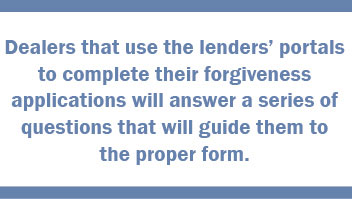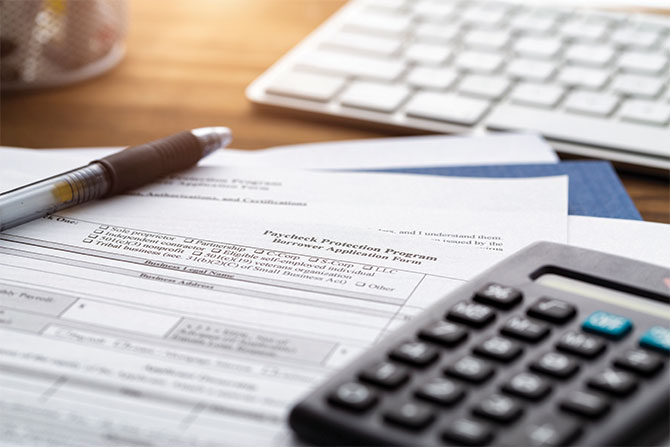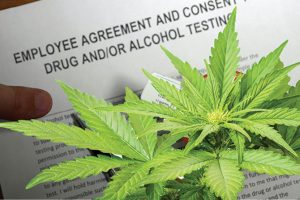By Wilfredo Fernandez and Giuseppe Bueti
2020 has become a roller coaster year for auto dealers. Everything appeared to be moving along just fine until the arrival of COVID-19. The spring was a period of uncertainty for dealers. Dealerships were forced to briefly shutter their doors, resulting in a significant reduction in revenue, furloughed or laid off employees and the rise of financial uncertainty.
In late April, the Federal government injected stimulus into the economy through the CARES Act that included the Paycheck Protection Program (PPP). The opportunity to obtain a PPP loan provided dealers with the financial beacon to guide them through the fog of COVID-19. Now, dealers need to focus on PPP Loan Forgiveness.
Necessity Certification
On October 26, 2020, the Small Business Administration (SBA) published a notice related to additional filing forms, with the intent to gather supplemental information. Form 3509 will be used for documenting the necessity certification. This form requires financial information related to business activity and liquidity for those whose PPP loan(s) (including affiliates) is in excess of $2,000,000. The intent is to facilitate the collection of supplemental information (including certifications and disclosure of quarterly revenues, distributions, compensation levels to owners and employees and more). SBA loan reviewers, to evaluate the good-faith certification that was made on the PPP borrower application that economic uncertainty made the loan request necessary, will use this information. The form will be issued by the lender servicing the loan, and the completed form is due within 10 business days of receipt from the lender.
Does this recent filing requirement apply to auto dealers? Any individual dealership that obtained a PPP loan of $2M or more must complete Form 3509.
Does the additional disclosure required by Form 3509 apply to an auto dealer with affiliated dealerships that obtained loans of less than $2M but taken together exceeded $2M? The draft instructions for Form 3509, reference 85 FR 20817, issued on April 15, 2020, regarding the application of SBA’s affiliation rules. Under these rules, the PPP affiliation rules do not apply to any business operating as a franchise that is assigned a franchise identifier code (FIC) by SBA. Dealers operating new car franchises fall under this waiver and do not need to aggregate individual PPP loans to determine if the completion of form 3509 is required.
Change in Ownership
On October 2, 2020, the SBA issued a notice explaining required procedures when an entity that has received a PPP loan has a change in ownership. Borrowers must notify their PPP lenders in writing prior to the closing of any change in ownership, which occurs when at least 20% of common stock or other ownership interest in a PPP borrower is sold or transferred, or when the borrower sells or transfers at least 50% of its assets or when the borrower merges with or into another entity.
The lender may approve a change in ownership without prior SBA approval for changes structured as a sale or transfer of common stock or other ownership interest as a merger or asset sale. Sales or transfers of ownership interest and mergers are exempt from SBA approval provided the transfer or sale is 50% or less of the ownership interest or the borrower submits a PPP forgiveness application. The borrower may escrow funds equal to the outstanding PPP loan balance. Asset sales of 50% or more of the borrower’s assets (measured at fair market value) requires the filing of a forgiveness application and funds escrowed equal to the outstanding PPP loan balance. In all other cases, the PPP lender must submit a request for SBA approval to the appropriate SBA Loan Servicing Center.
A selling dealership will notify their lender and be prepared to escrow funds equal to the PPP loan balance. After the forgiveness process is completed, the escrow funds must be disbursed first to repay any remaining PPP loan balance plus interest; the balance is returned to the selling dealership.
Taxation
Is the forgiveness of the PPP loan taxable? The answer is important and will affect the year-end taxation for dealers.
For Federal purposes, PPP loan forgiveness shall be excluded from gross income. However, the IRS issued Notice 2020-32 in April 2020, stating that the tax-free income expenses are nondeductible. This guidance was consistent with historic IRS guidance regarding nontaxable income and related expenses. This had the net effect of essentially reversing the tax-free benefit of excluding the loan forgiveness from gross income.
In late December 2020, the Consolidated Appropriations Act, 2021 (CAA) became law. CAA clarifies auto dealers whose PPP loans are forgiven are allowed deductions for otherwise deductible expenses paid with the proceeds of a PPP loan, restoring the loan forgiveness’s federal tax-free benefit.
Is forgiveness taxable in New Jersey? Absent any legislation being passed or guidance being issued by the State of New Jersey, PPP loan forgiveness is nontaxable for New Jersey auto dealers.
Many auto dealers operate as a New Jersey S corporation, Partnership or Limited Liability Company (LLC). The aforementioned are entities that pass-through the tax attributes to their shareholders, partners or members. For New Jersey gross income tax purposes, a loan and forgiveness of that loan, are not taxable income for the individuals as net profits from the business. Additionally, business costs or expenses related to business income exempt from tax under the Gross Income Tax Act, or which are partly or wholly nondeductible for Federal income tax purposes, may be deductible ordinary business costs or expenses under the Gross Income Tax Act. Therefore, the PPP loan forgiveness is not taxable and the expenses incurred to obtain PPP loan forgiveness are deductible, making the PPP loan forgiveness nontaxable for NJ pass-through entities.
New Jersey C corporations follow Federal guidance. With the CAA passage, the PPP loan forgiveness is nontaxable for auto dealers that operate as New Jersey C corporations.
Timing of Forgiveness Application
Dealers have until the maturity date of the loan to apply for forgiveness. However, 10 months after the end of their Covered Period, the borrower must make principal and interest payments to their lender unless an application for forgiveness has been submitted. The Covered Period is the 24-week (168 day) period beginning on the PPP loan disbursement date. The lender has 60 days to review the forgiveness application and forward it to the SBA for review. The SBA has 90 days to approve the forgiveness amount. Any portion of the PPP loan that is not forgiven will be treated as a loan, payable with interest at 1% from the loan issuance date, with a maturity of two years for loans issued before June 5, 2020, or five years for loans issued after June 5, 2020.
Which Form Do I Use?
The SBA provides three different forgiveness applications.
Form 3508S — File this application if:
- The total PPP loan amount you received from your Lender was $50,000 or less, and the total PPP loans received, together with affiliates, amounted to less than $2M. This simplified form will not apply to most dealers since dealership loans typically exceeded $50,000.
Form 3508EZ — File this application if:
- During the Covered Period, the dealership had no salary or wage reduction over 25% for employees that did not receive, in any single pay period in 2019, wages and salaries at an annualized rate of more than $100,000 and either no reduction in Full-Time Equivalent (FTE) OR meets FTE safe harbor based on inability to operate at the same level of business.
Form 3508 — File this application if not eligible to file Form 3508S or 3508EZ.
Dealers that use the lenders’ portals to complete their forgiveness applications will answer a series of questions that will guide them to the proper form. It will be useful to have Form 3508 completed since the lender portals simulate the form and make the application process quicker.

Determination of Forgiveness Amount
The forgiveness amount is lower of:
- Modified total (the sum of all qualified costs less any salary/wage reductions adjusted for any FTE reduction)
- PPP Loan Amount
- Qualified Payroll cost divided by 60%
Note that any reductions are calculated on the total qualified costs. For example, a dealership received a PPP loan of $750,000, spent $1,500,000 in qualified cost and incurred a 30% FTE reduction. This will result in a modified total of $1,050,000 ($1,500,000 X 0.70). In this case, the dealership will still have full forgiveness because the modified total, after reduction, would be more than the PPP loan amount.
Qualified Cost
Qualified costs eligible for forgiveness include both payroll costs and non-payroll costs. Payroll costs need to be incurred and paid during the Covered Period (or the Alternative Payroll Covered Period) or paid on or before the next regular payroll date. Non-payroll costs need to be incurred or paid during the covered period or paid on or before the next regular billing date.
Payroll costs include all forms of cash compensation paid to employees, including tips, commissions, bonuses and hazard pay. Note that forgivable cash compensation per employee is limited up to $46,154 for non-owners during the 24-week Covered Period. Employers may also elect to use the Alternative Payroll Covered Period if the payroll frequency is weekly or biweekly. This allows you to move the Covered Period’s start date to the first day of the payroll week after receiving PPP loan proceeds. Other Payroll costs include employer-paid health insurance, employer-paid retirement plan contributions and employer payments for state and local payroll taxes assessed on employee earnings.
Compensation for owner-employees, self-employed individuals or general partners — The eligible cost is the lesser of $20,833 or 2.5/12 of their 2019 compensation. Non-cash benefits for owner-employees will depend on the business tax structure. For S corporations: employer health insurance is not allowed for owners and family members of 2% shareholders. For LLC members/partners: employer health insurance, retirement contributions and state & local taxes are not allowed.
Non-payroll costs such as rent, utilities (electricity, gas, water, telephone, etc.) and mortgage interest had to be in effect or service as of February 15, 2020. It is important to note that rent paid to related parties (dealer-owned real estate) is limited to the amount of the mortgage interest paid on the property during the Covered Period.
Reductions to PPP Loan Forgiveness
Qualified costs must be reduced by the dealership’s reduction for salary and wage reductions and reductions in FTEs. If an employee’s base salary or hourly rate was reduced by more than 25% when compared to the measurement period (Q1 2020), a reduction to forgiveness is applied by calculating the difference in rate between the Covered Period and the measurement period (multiplied by 0.75) and applying that difference to the hours worked during the Covered Period. For example, if an employee earned $20 per hour during the measurement period and $14 per hour during the Covered Period, the wage reduction is $1 per hour ($20 x 0.75 = $15 – $14). If the employee worked 500 hours during the Covered Period, the wage reduction is $500 ($1 x 500). This is subtracted from the dealership’s total qualified costs. Note that employees who were paid more than $100,000 at any time during 2019 and new hires are not included in this calculation. Also, note that the reduction for salaries is calculated on the base salary and does not include commissions or bonuses.
The FTE reduction is calculated by taking the average FTE for the Covered Period (or Alternative Payroll Covered Period, if used) and dividing it by the Borrowers choice of reference periods:
- February 15, 2019 — June 30, 2019;
- January 1, 2020 — February 29, 2020);
If the average FTE for the Covered Period is less than the reference period, then the percentage decrease would result in an “FTE Reduction Quotient” of less than 1.0. For example, if you had 100 FTEs in the reference period and only 70 FTEs during your Covered Period, you would have a 70% FTE Reduction Quotient (70/100).
Safe Harbors
Certain safe harbors are provided for businesses unable to maintain their FTEs and pay rates during the Covered Period. Forgiveness will not be reduced under the following circumstances:
- There is a safe harbor for Salary/Hourly Wage Reduction. In the previous example (the employee with the rate of pay that was reduced from $20 per hour to $14), if the rate was restored during the pay period that includes 2/15/2020 ($20) and the date the forgiveness application is submitted, the safe harbor is met. In that case, the $500 reduction will not be a reduction to the forgiveness amount.
Additionally, there are exceptions to the FTE reduction that may be applied:
- If the borrower makes a good-faith, written offer to rehire or restore the reduced hours of an employee during the Covered Period or the Alternative Payroll Covered Period, the offer was rejected, and the borrower has documentation of the offer and rejection and notified the State’s Unemployment Division;
- Employee was fired for cause;
- An employee voluntarily resigned;
- An employee requested and received a reduction of their hours;
- The borrower, in good faith, can document the inability to rehire individuals who were employees on February 15, 2020, and hire similarly qualified employees for unfilled positions on or before December 31, 2020, or the date of the application for forgiveness;
Safe Harbor 1 is the most relevant of the safe harbors and reads as follows, “If you were unable to operate between February 15, 2020, and the end of the Covered Period at the same level of business activity as before February 15, 2020, due to compliance with requirements established or guidance issued between March 1, 2020, and December 31, 2020, by the Secretary of Health and Human Services, the Director of the Centers for Disease Control and Prevention, or the Occupational Safety and Health Administration, related to the maintenance of standards for sanitation, social distancing, or any other worker or customer safety requirement related to COVID-19”, you will not need to apply an FTE Reduction Quotient to your qualified costs. It may be difficult for dealerships to qualify for this safe harbor.
Safe Harbor 2 allows the Borrower that had a reduction in FTE employee levels between February 15 and April 26, 2020, the ability to restore its FTE employee levels by no later than December 31, 2020, or the date of the forgiveness application to FTE levels in the pay period that included February 15.
The PPP loan forgiveness application process is complex and ever-changing. It is important that dealers are communicating with their lenders, CPAs and attorneys to assist them through the process.
Wilfredo Fernandez is a CPA and Partner at Citrin Cooperman & Company, LLP. Giuseppe Bueti is a Director at the same organization. They can be reached at 973.218.0500 or via email at wfernandez@citrincooperma.com and
gbueti@citrincooperman.com, respectively.
This story appears in Issue 4 2020-21 of the New Jersey Auto Retailer Magazine.







